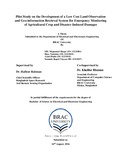Pilot study on the development of a low cost land observation and geo-information retrieval system for emergency monitoring of agricultural crop and disaster-induced damages
Abstract
A pilot study has been performed under this thesis work in view of establishing a Space-based Emergency Geoinformation Support Service System equipped with necessary Remote Sensing (RS), GIS and ICT functionalities and working blocks as an aid to decision making processes at policy level and management level. The work under the thesis includes integrated application of remote sensing sciences, geo-information technology and UAV (locally made quad copter) technology for emergency observation over limited area as a supplement to remote sensing study for correction and validation operation. Surface features like soil, vegetation and water are the major category of surface features over a given area. The UAV actually is a locally made quad copter. The dedicated system has been designed and developed for acquisition of spectral images for emergency observation under major disaster events, environmental problems and agricultural crop monitoring to acquire emergency information over specific area at specific height and location. The designed system includes a moving flying platform in the present case it is a quad copter for holding necessary remote sensing device with special arrangement for carrying out measurements. The quad copter is guided through a GPS-guided mission plan covering a disaster affected given area with arrangement for mounting of sensing device with a mechanism to minimize tilting and axial movement during data acquisition. The purpose is to facilitate the emergency information retrieval process in the remote area where monitoring through land vehicle is time consuming and difficult. Using the software, we can perform mission planning by specifying giving the way point of the area to be monitored and the quadcopter will be instructed to cover that area and acquire images using a high resolution digital camera mounted in the quadcopter. After acquisition of a series of images as specified in the mission plan, all the individual images are geometrically corrected, georeferenced and finally mosaicked to produce a single image block. At this stage, software has been prepared through coding of algorithm of SMAC (Simplified Method of Atmospheric Correction) to perform necessary atmospheric correction of the acquired images. The developed software performs necessary atmospheric correction of acquired images which are affected by external factors like atmospheric aerosol and other gaseous constituents in the atmosphere. Subsequently the corrected image will be geo-referenced using ERDAS Imagine software. The remaining operation of information retrieval has been made carried out through a model-based approach using spatial modeler language available in the professional Image Processing Software “ERDAS Imagine”. Information on surface features particularly agricultural crop, damaged areas, exposed soil etc. are obtained based on the acquired images and damaged areas are also identified. The whole system seems to be supportive to food security, disaster induced damage assessment, environmental disturbances analysis etc.

